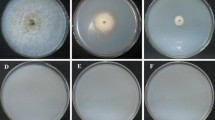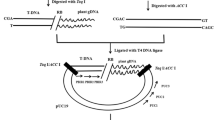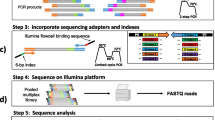Abstract
We present a highly effective T-DNA inserted gene screening method as part of a reverse genetics model system using the Chinese cabbage (Brassica rapa L. spp. pekinensis). Three-step two-dimensional (2D) matrix strategies are potentially accurate and useful for the identification of specific T-DNA inserted mutants from a large population. To construct our Chinese cabbage model, we utilized a forward genetics screening approach for the abnormal phenotypes that were obtained from transgenic plants of Brassica rapa generated with Agrobacteria tumefaciens containing the pRCV2 vector. From one transgenic plant with an abnormal phenotype, we observed that the st1 gene (which is related to senescence-associated process proteins) contained a T-DNA fragment, and that its expression level was decreased. This T-DNA insert was then used as a control to construct an effective screening pool. As a result, the optimum template concentration was found to be 0.1–1 ng in our PCR strategy. For other conditions, positive changes to the Gibbs free energy prevented the formation of oligo dimers and hairpin loop structures, and autosegment extension gave better results for long fragment amplification. Using this effective reverse genetics screening method, only 23 PCR reactions were necessary to select a target gene from a pool of 100 individual DNAs. Finally, we also confirmed that the sequence we obtained from the above method was identical to the flanking sequence isolated by rescue cloning.








Similar content being viewed by others
References
Abd-Elsalam KA (2003) Bioinformatic tools and guideline for PCR primer design. Afr J Biotechnol 15:555–557
Alphey MS, Williams RA, Mottram JC, Coombs GH, Hunter WN (2003) The crystal structure of Leishmania major 3-mercaptopyruvate sulfurtransferase. A three-domain architecture with a serine protease-like triad at the active site. J Biol Chem 278:48219–48227
Breslauer KJ, Ronald F, Blocker H, Marky LA (1986) Predicting DNA duplex stability from the base sequence. Proc Natl Acad Sci 83:3746–3750
Han SJ, Kim DS (2002) AtRTPrimer: database for Arabidopsis genome-wide homogeneous and specific RT-PCR primer-pairs. BMC Bioinformatics 7:179–187
Kandasamy MK, Deal RB, McKinney EC, Meagher RB (2005) Silencing the nuclear actin-related protein AtARP4 in Arabidopsis has multiple effects on plant development, including early flowering and delayed floral senescence. Plant J 41:845–858
Kende H (1993) Ethylene biosynthesis. Annu Rev Plant Physiol 44:283–307
Kim HS, Kim SH, Park YD (2003) Development of rescue cloning vector with phophinothricin resistant gene for effective T-DNA tagging. Korean J Hortic Sci 18:594–598
Larsen M, Ucisik AS, Trapp S (2005) Uptake, metabolism, accumulation and toxicity of cyanide in willow trees. Environ Sci Technol 39:2135–2142
Lee MK, Kim HS, Kim JS, Kim SH, Park YD (2004) Agrobacterium-mediated transformation system for large-scale production of transgenic Chinese cabbage (Brassica rapa L. ssp. pekinensis) plants for insertional mutagenesis. J Plant Biol 47:300–306
Livak KJ, Schmittgen TD (2001) Analysis of relative gene expression data using real-time quantitative PCR and 2ΔΔC(T) method. Methods 25:402–408
McCouch SR, Kochert G, Yu ZH, Wang ZY, Khush GS, Coffman WR, Tanksley SD (1998) Molecular mapping of rice chromosomes. Theor Appl Genet 76:815–829
Meyer T, Burow M, Bauer M, Papenbrock J (2003) Arabidopsis sulfurtransferases: investigation of their function during senescence and in cyanide detoxification. Planta 217:1–10
Mukai H, Nakagawa T (1996) Long and accurate PCR (LA PCR). Nippon Rinsho 54:917–922
Ohler LD, Rose EA (1992) Optimization of long-distance PCR using a transposon-based model system. PCR Methods Appl 2:51–59
Rahmann S, Gräfe C (2004) Mean and variance of the Gibbs free energy of oligonucleotides in the nearest neighbor model under varying conditions. Bioinformatics 20:2928–2933
Sahdev S, Saini S, Tiwari P, Saxena S, Singh SK (2007) Amplification of GC-rich genes by following a combination strategy of primer design, enhancers and modified PCR cycle conditions. Mol Cell Probes 21:303–307
Sambrook J, Russel DW (2001) Southern hybridization. In: Molecular cloning: a laboratory manual, 3rd edn. Cold Spring Harbor Laboratory Press, New York
SantaLucia J (1998) A unified view of polymer, dumbbell, and oligonucleotide DNA nearest-neighbor thermodynamics. Proc Natl Acad Sci USA 95:1460–1465
Southern EM (1975) Detection of specific sequences among DNA fragments separated by gel electrophoresis. J Mol Biol 98:503–517
Yang SF, Hoffman NE (1984) Regulation of ethylene biosynthesis. Annu Rev Plant Physiol 35:155–189
Yang TJ, Kim JS, Lim KB, Kwon SJ, Kim JA, Jin MN, Park JY, Lim MH, Kim HI, Kim SH, Lim YP, Park BS (2005) The Korea Brassica Genome Project: a glimpse of the Brassica genome based on comparative genome analysis with Arabidopsis. Comp Funct Genomics 6:138–146
Yukihiro K, Shuuji O, Osamu I, Naotsune S (2003) Effect of DMSO on PCR of Porphyra yezoensis (Rhodophyta) gene. J Appl Phycol 15:555–557
Acknowledgments
This work was supported by grants (Code # 2007030103403700801 and Code # 2008040103403900805) from the BioGreen 21 Program, Rural Development Administration, Republic of Korea.
Author information
Authors and Affiliations
Corresponding author
Rights and permissions
About this article
Cite this article
Lee, GH., Kang, YJ., Yi, SK. et al. Development of a highly effective T-DNA inserted mutant screening method in a Chinese cabbage (Brassica rapa L. spp. pekinensis) reverse genetics system. Plant Biotechnol Rep 4, 201–211 (2010). https://doi.org/10.1007/s11816-010-0137-0
Received:
Accepted:
Published:
Issue Date:
DOI: https://doi.org/10.1007/s11816-010-0137-0




